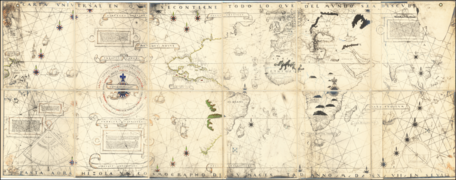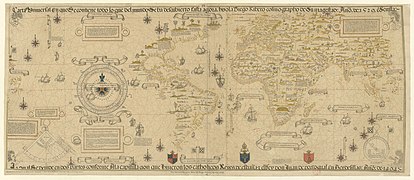Early world maps
The earliest known world maps date to classical antiquity, the oldest examples of the 6th to 5th centuries BCE still based on the flat Earth paradigm. World maps assuming a spherical Earth first appear in the Hellenistic period. The developments of Greek geography during this time, notably by Eratosthenes and Posidonius culminated in the Roman era, with Ptolemy's world map (2nd century CE), which would remain authoritative throughout the Middle Ages. Since Ptolemy, knowledge of the approximate size of the Earth allowed cartographers to estimate the extent of their geographical knowledge, and to indicate parts of the planet known to exist but not yet explored as terra incognita.
Further information: List of historical maps and history of cartographyWith the Age of Discovery, during the 15th to 18th centuries, world maps became increasingly accurate; exploration of Antarctica, Australia, and the interior of Africa by western mapmakers was left to the 19th and early 20th century.
Antiquity[edit]
Bronze Age Saint-Bélec slab[edit]
The Saint-Bélec slab discovered in 1900 by Paul du Châtellier, in Finistère, France, is dated to between 1900 BCE and 1640 BCE. A recent analysis, published in the Bulletin of the French Prehistoric Society, has shown that the slab is a three-dimensional representation of the River Odet valley in Finistère, France. This would make the Saint-Bélec slab the oldest known map of a territory in the world. According to the authors, the map probably was not used for navigation, but rather to show the political power and territorial extent of a local ruler’s domain of the early Bronze age.[1][2][3][4]
![]() Media related to Maps of the world before Columbus at Wikimedia Commons
Media related to Maps of the world before Columbus at Wikimedia Commons



